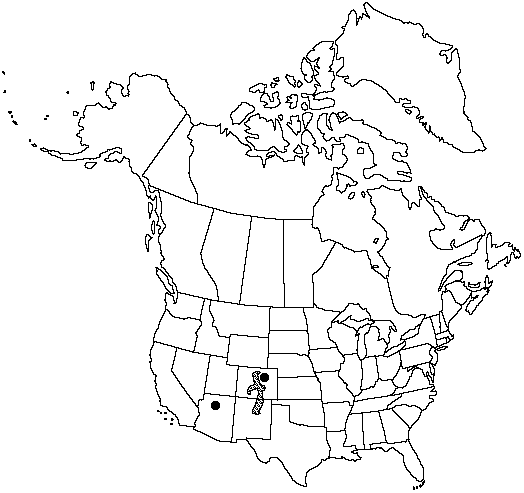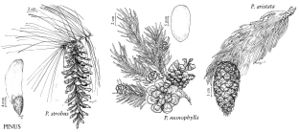Difference between revisions of "Pinus aristata"
in Parry & Engelmann, Amer. J. Sci. Arts ser. 2, 34: 331. 1862.
FNA>Volume Importer |
imported>Volume Importer |
||
| (2 intermediate revisions by 2 users not shown) | |||
| Line 1: | Line 1: | ||
{{Treatment/ID | {{Treatment/ID | ||
|accepted_name=Pinus aristata | |accepted_name=Pinus aristata | ||
| − | |accepted_authority= | + | |accepted_authority=Engelmann |
|publications={{Treatment/Publication | |publications={{Treatment/Publication | ||
| − | |title=in Parry & Engelmann,Amer. J. Sci. Arts | + | |title=in Parry & Engelmann, Amer. J. Sci. Arts |
|place=ser. 2, 34: 331. 1862 | |place=ser. 2, 34: 331. 1862 | ||
|year=1862 | |year=1862 | ||
}} | }} | ||
|common_names=Colorado bristlecone pine | |common_names=Colorado bristlecone pine | ||
| + | |special_status={{Treatment/ID/Special_status | ||
| + | |code=F | ||
| + | |label=Illustrated | ||
| + | }}{{Treatment/ID/Special_status | ||
| + | |code=E | ||
| + | |label=Endemic | ||
| + | }} | ||
|basionyms= | |basionyms= | ||
|synonyms={{Treatment/ID/Synonym | |synonyms={{Treatment/ID/Synonym | ||
| Line 36: | Line 43: | ||
-->{{#Taxon: | -->{{#Taxon: | ||
name=Pinus aristata | name=Pinus aristata | ||
| − | |authority= | + | |authority=Engelmann |
|rank=species | |rank=species | ||
|parent rank=genus | |parent rank=genus | ||
| Line 46: | Line 53: | ||
|distribution=Ariz.;Colo.;N.Mex. | |distribution=Ariz.;Colo.;N.Mex. | ||
|reference=None | |reference=None | ||
| − | |publication title=in Parry & Engelmann,Amer. J. Sci. Arts | + | |publication title=in Parry & Engelmann, Amer. J. Sci. Arts |
|publication year=1862 | |publication year=1862 | ||
| − | |special status= | + | |special status=Illustrated;Endemic |
| − | |source xml=https:// | + | |source xml=https://bitbucket.org/aafc-mbb/fna-data-curation/src/2e0870ddd59836b60bcf96646a41e87ea5a5943a/coarse_grained_fna_xml/V2/V2_619.xml |
|genus=Pinus | |genus=Pinus | ||
|species=Pinus aristata | |species=Pinus aristata | ||
Latest revision as of 20:24, 5 November 2020
Trees to 15m; trunk to 1m diam., strongly tapering, twisted; crown rounded, flattened (sheared), or irregular. Bark gray to red-brown, shallowly fissured, with long, flat, irregular ridges. Branches contorted; twigs pale red-brown, aging gray, puberulent, young branches resembling long bottlebrushes because of persistent leaves. Buds ovoid-acuminate, pale red-brown, ca. 1cm, resinous. Leaves 5 per fascicle, upcurved, persisting 10–17 years, (2–)3–4cm × 0.8–1mm, mostly connivent, deep blue-green, with drops and scales of resin, abaxial surface with strong, narrow median groove, adaxial surfaces conspicuously whitened by stomates, margins entire or distantly serrulate, apex conic-acute to conic-subulate; sheath 0.5–1.5cm, scales soon recurving, shed early. Pollen cones ellipsoid, ca. 10mm, bluish to red. Seed cones maturing in 2 years, shedding seeds and falling soon thereafter, spreading, symmetric, lance-cylindric before opening, lance-ovoid to ovoid or cylindric when open, 6–11cm, purple to brown, nearly sessile; apophyses much thickened; umbo central, with triangular base, extended into slender, brittle prickle 4–10mm. Seeds obliquely obovoid; body 5–6mm, gray-brown to near black; wing ca. 10–13mm. 2n =24.
Habitat: Subalpine and alpine
Elevation: 2500–3400m
Distribution

Ariz., Colo., N.Mex.
Discussion
Pinus aristata has leaves usually narrower and sharper than in P. longaeva and P. balfouriana, and the leaves almost always have a narrow, median groove on the abaxial surface.
Selected References
None.
